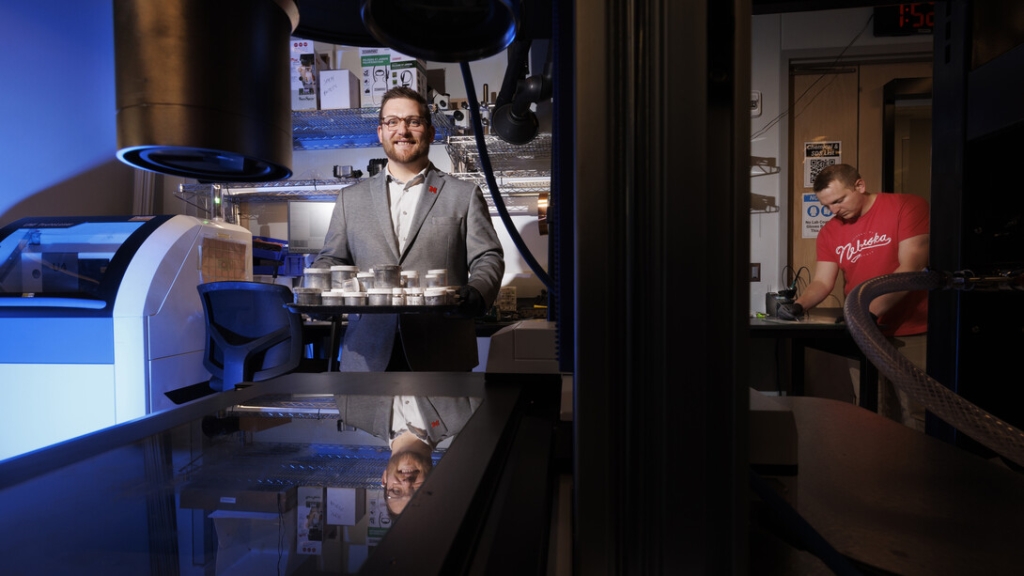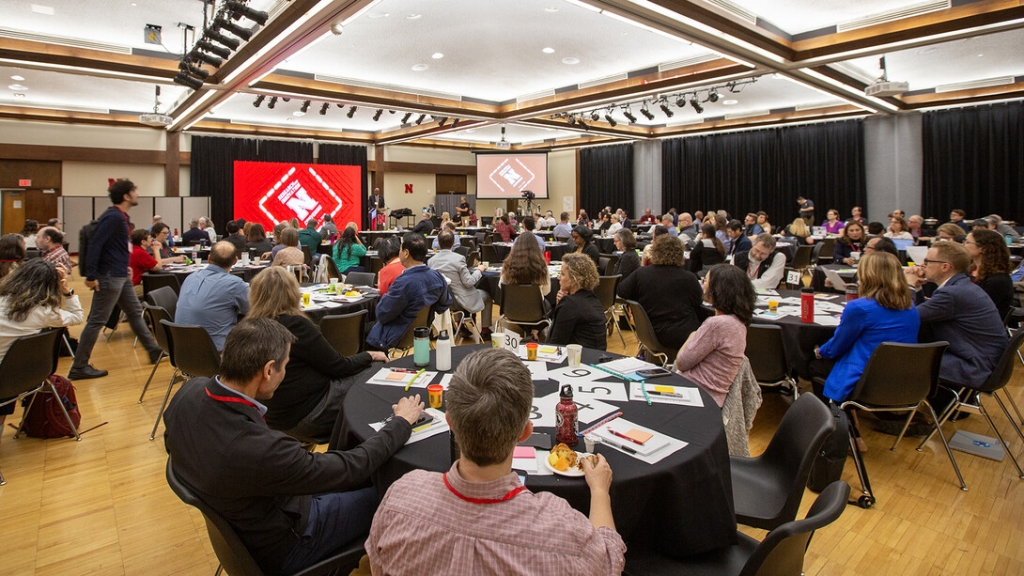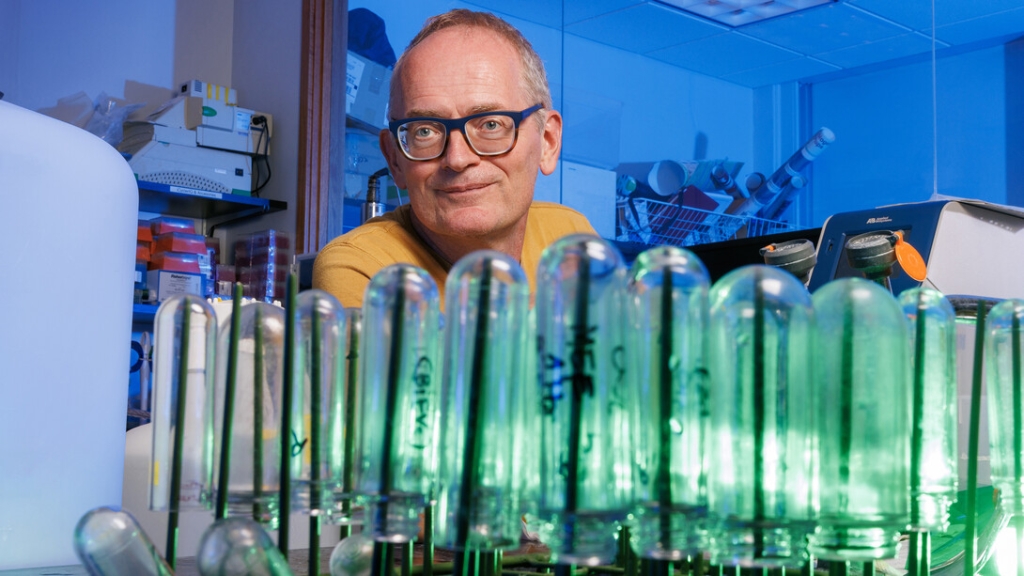Posted May 30, 2025 by Tiffany Lee
In case you missed these stories highlighting research and creative activity at the University of Nebraska-Lincoln, the Office of Research and Innovation’s communications team has compiled a roundup of some top research stories from research.unl.edu and other sources.

Husker engineers advance work on intelligent, self-healing technology
Who: Eric Markvicka, Robert F. and Myrna L. Krohn Assistant Professor of Biomedical Engineering; Ethan Krings, graduate student in mechanical and materials engineering; Patrick McManigal, graduate student in computing
What: Markvicka’s team recently presented a paper at the IEEE International Conference on Robotics and Automation that sets forth a systems-level approach for a soft robotics technology that can identify damage from a puncture or extreme pressure, pinpoint its location and autonomously initiate self-repair. The paper was among the 39 of 1,606 submissions selected as an ICRA 2025 Best Paper Award finalist. The team’s intelligent, self-healing artificial muscle features an architecture with three layers: a bottom damage detection layer, a middle self-healing layer and a top actuation layer. Damage triggers formation of electrical networks between baseline monitoring traces on the bottom layer, which enables the system to detect and localize damage via Joule heating. To erase these networks and reset the system, a current induces electromigration and thermal failure mechanisms. Self-healing technology could help stem the tide of toxin-containing electronic waste.
“If we can begin to create materials that are able to passably and autonomously detect when damage has happened, and then initiate these self-repair mechanisms, it would really be transformative,” Markvicka said.
Writer: Tiffany Lee, Office of Research and Innovation

Nebraska U charts course to elevate research distinction
Who: More than 260 faculty, campus administrators and community leaders
What: The Research and Innovation Convening, a strategic planning summit focused on research identity and community collaboration, took place May 7. Led by the Office of Research and Innovation, the daylong event featured national experts, panel discussions on successful community partnerships, a recording booth allowing faculty to tell their individual research stories, and interactive sessions designed to get faculty thinking beyond traditional research boundaries. Jen Nelson, interim vice chancellor for research and innovation, introduced a draft framework outlining five research identity areas, which include 34 specific topics. The five areas are: bioindustry and agriculture; energy and material sciences; transportation, robotics and autonomous technologies; social, behavioral, education and prevention sciences; basic mechanisms of disease; and areas of cross-cutting distinction.
“Finding an institutional research identity can be challenging, but this is our opportunity to lead — to define what makes the University of Nebraska–Lincoln truly distinctive,” Nelson said. “As we move forward, I encourage you to consider the benefits of being recognized for excellence in specific areas: it enhances our reputation, increases external funding opportunities, strengthens research activity, enriches student learning and reinforces our institutional stability.”
Writer: Troy Fedderson, University Communication and Marketing

Husker team wins second-round prize in NIH gene editing challenge
Who: Janos Zempleni, Willa Cather Professor of molecular nutrition; Jiantao Guo, professor of chemistry
What: Zempleni received a second-round prize in the National Institutes of Health’s Targeted Genome Editor Delivery (TARGETED) Challenge. Fourteen teams, including researchers from some of the nation’s most prestigious institutions, received a Phase 2 prize and are eligible to compete in the initiative’s third and final phase. The $250,000 prize will help Zempleni’s team advance work on the scalability of “designer milk exosomes,” which are natural nanoparticles from milk that can be loaded with various types of cargo, including therapeutics, plasmids or gene editors. When certain peptides are attached to the exosomes, they can transport gene editing technology to the precise tissues and organs associated with a given disease. Large-scale production is an advantage of Zempleni’s approach, as milk contains approximately 1014 exosomes per milliliter.
“The beauty is we can take the exosomes out of cow’s milk,” he said. “We have an unlimited supply of the vehicle, we just have to modify it by attaching our synthetically made peptides. In theory, we could deliver these exosomes in large quantities tomorrow.”
Writer: Tiffany Lee, Office of Research and Innovation

Husker team narrows math teaching gaps via innovative program
Who: Amy Bennett, Wendy Smith and Rachel Funk, Center for Science, Mathematics and Computer Education; Dannika and Merritt Nelson, ImpactED Global
What: The Husker researchers are partnering with ImpactED Global, a Nebraska-based, education-focused startup company, on a project that paves the way for enhanced professional development opportunities for Nebraska’s K-8 math teachers. The team recently finished the project’s first phase, which was funded in part by a grant from the Nebraska Department of Economic Development’s Nebraska Academic Research and Development program. Using ImpactED’s Personalized, Differentiated Professional Development, or PD2, tool, the team gathered data highlighting the need for individualized, standards-based professional development for Nebraska’s math teachers. The project showcases the potential of PD2 to deepen teachers’ understanding of math content.
“Our company’s research indicates that one major reason math proficiency levels nationwide have been at record lows is a disconnect between teachers’ understanding of the material and state requirements for student proficiency,” said Merritt Nelson, ImpactED CEO. “Our PD2 toolis aimed at correcting that mismatch by providing teachers tailored knowledge, tools and strategies. The partnership with UNL is enabling us to further develop PD2 and continue to scale our impact by supporting teachers in eight districts across Nebraska, which will ultimately improve learning outcomes for thousands of Nebraska students.”
Writer: Tiffany Lee, Office of Research and Innovation

Nebraska-developed vaccine protects against swine, human and bird flu
Who: Eric Weaver, professor of biological sciences and director of the Nebraska Center for Virology, and his laboratory team
What: In a study published April 30 in Nature Communications, Weaver’s team describes a vaccine that protects against H1N1 swine flu and can also protect against influenza in humans and birds. The work sets the stage for development of a universal influenza vaccine, which would enable people to avoid a yearly shot. In the study, swine vaccinated with the Epigraph vaccine – named after the computer software used to design it – significantly outperformed a commercial vaccine used in the pork industry and a “wild type” vaccine. These results confirm previous research demonstrating the vaccine design protected against the H3 influenza subtype; the new findings are encouraging because H1 swine flu variants are detected twice as often as H3 variants and are more genetically diverse. The work may also curb cross-species transmission to humans.
“If we can prevent influenza in swine, we can also prevent zoonotic jumps from avians to swine to humans, or from swine directly to humans. We could basically cut off this evolutionary arsenal or advantage that the virus has,” Weaver said. “The ultimate goal is to eliminate or eradicate influenza.”
Writer: Leslie Reed, University Communication and Marketing

Study shows importance of autonomy in social media recruitment for clinical trials
Who: Ciera Kirkpatrick, assistant professor of advertising and public relations
What: Kirkpatrick and colleagues recently published a study in Health Communication focused on use of social media, particularly short-form videos, to recruit participants for clinical trials. Though such trials are critical to advancing new treatments, recruiting participants can be difficult due to time constraints, safety concerns, lack of awareness and more. Kirkpatrick’s team examined how social media may bolster recruitment efforts. The researchers found that videos containing autonomy-supportive messages – or those that gave a sense of agency or control to the viewer – were most effective. Autonomy-supportive messaging also increased engagement, which is important to social media algorithms.
“The autonomy support increased their likelihood of wanting to engage with the videos, which is really important within a social media context,” Kirkpatrick said. “The more likes and shares and comments something gets, then the more people are going to see it, which could be helpful in terms of getting more people to become familiar with clinical trials and interested in participating.”
Writer: Deann Gayman, University Communication and Marketing

Husker research unlocks secrets of sorghum’s defenses against fall armyworm
Who: Joe Louis, Harold W. Eberhard Professor of agricultural entomology; Scott Sattler, genomics scientist, U.S. Department of Agriculture’s Agricultural Research Service; Pritha Kundu, postdoctoral research associate in entomology; Sanket Shinde, recent doctoral graduate in entomology
What: Louis’ team published a paper in Plant Physiology identifying how a certain sorghum gene, Brown midrib 12 (Bmr12), contributes to the production of certain hormones and flavonoids that disrupt the growth and development of fall armyworm, a major pest threat. These voracious caterpillars harm a wide range of crops, including corn and soybeans, threatening food security and agricultural sustainability. The team’s exploration of Bmr12 opens the door for breeding or gene editing to create hybrids with stronger natural resistance. The next step is identifying the specific flavonoids that each crop uses as a defense. This collaborative UNL-USDA research was supported with funding from the Plant Biotic Interactions Program, a joint initiative of the USDA’s National Institute of Food and Agriculture and the National Science Foundation, and NIFA’s Pests and Beneficial Species in Agricultural Production Systems program.
“Natural plant compounds like flavonoids could be used to help protect sorghum from fall armyworm and potentially other insect pests in a safer, non-toxic way,” Louis said.
Writer: Geitner Simmons, Institute of Agriculture and Natural Resources





